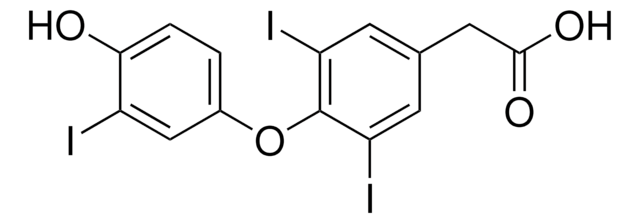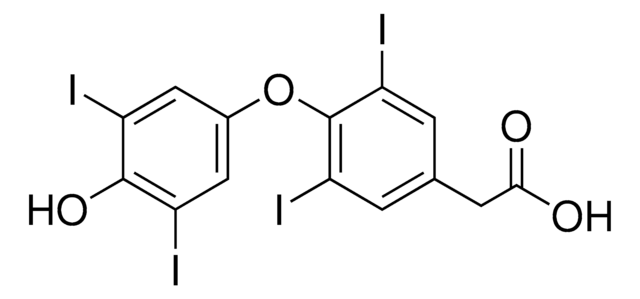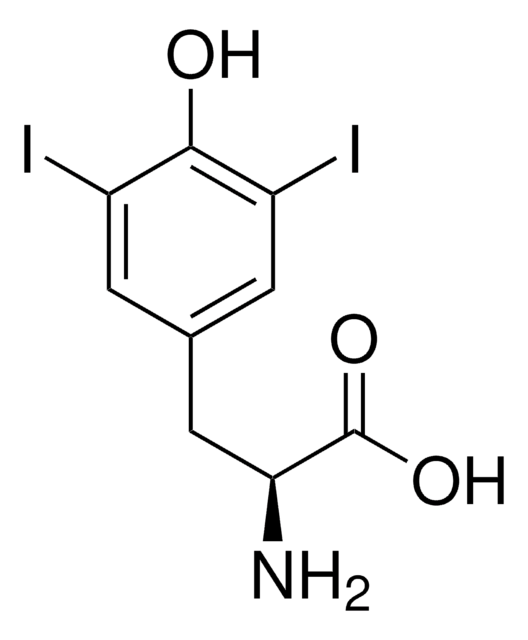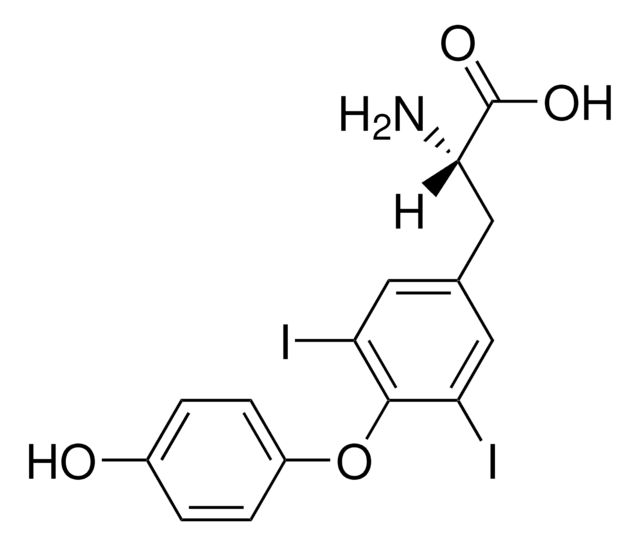1368008
USP
Liothyronine
United States Pharmacopeia (USP) Reference Standard
Sinonimo/i:
3,3′,5-Triiodo-L-thyronine, O-(4-Hydroxy-3-iodophenyl)-3,5-diiodo-L-tyrosine, Liothyronine, T3
About This Item
Prodotti consigliati
Grado
pharmaceutical primary standard
Famiglia di API
liothyronine
Produttore/marchio commerciale
USP
Punto di fusione
234-238 °C (lit.)
applicazioni
pharmaceutical (small molecule)
Formato
neat
Temperatura di conservazione
2-8°C
Stringa SMILE
N[C@@H](Cc1cc(I)c(Oc2ccc(O)c(I)c2)c(I)c1)C(O)=O
InChI
1S/C15H12I3NO4/c16-9-6-8(1-2-13(9)20)23-14-10(17)3-7(4-11(14)18)5-12(19)15(21)22/h1-4,6,12,20H,5,19H2,(H,21,22)/t12-/m0/s1
AUYYCJSJGJYCDS-LBPRGKRZSA-N
Informazioni sul gene
human ... THRA(7067) , THRB(7068)
Cerchi prodotti simili? Visita Guida al confronto tra prodotti
Descrizione generale
Applicazioni
Also used to prepare standard, standard stock, Liothyronine stock, and resolution solutions for assay, and identification test according to given below monographs of the United States Pharmacopeia (USP):
- Thyroid
- Levothyroxine Sodium Tablets
- Liothyronine Sodium Tablets
Risultati analitici
Altre note
Prodotti correlati
Avvertenze
Danger
Indicazioni di pericolo
Consigli di prudenza
Classi di pericolo
STOT RE 1
Organi bersaglio
Thyroid,Cardio-vascular system,Kidney
Codice della classe di stoccaggio
6.1C - Combustible acute toxic Cat.3 / toxic compounds or compounds which causing chronic effects
Classe di pericolosità dell'acqua (WGK)
WGK 3
Punto d’infiammabilità (°F)
Not applicable
Punto d’infiammabilità (°C)
Not applicable
Scegli una delle versioni più recenti:
Certificati d'analisi (COA)
Ci dispiace, ma al momento non ci sono COA disponibili online per questo prodotto.
Se ti serve aiuto, non esitare a contattarci Servizio Clienti
Possiedi già questo prodotto?
I documenti relativi ai prodotti acquistati recentemente sono disponibili nell’Archivio dei documenti.
I clienti hanno visto anche
Il team dei nostri ricercatori vanta grande esperienza in tutte le aree della ricerca quali Life Science, scienza dei materiali, sintesi chimica, cromatografia, discipline analitiche, ecc..
Contatta l'Assistenza Tecnica.








